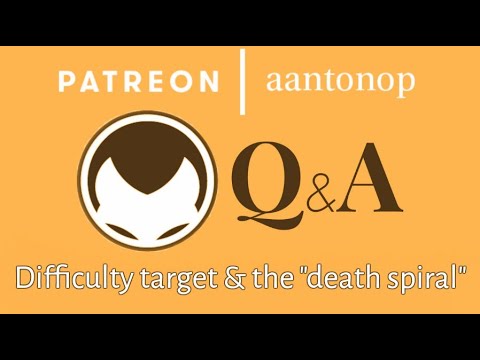What is difficulty and how is it adjusted? What if the difficulty could not be satisfied? Would sudden changes in mining hash power kill Bitcoin? Will mining ever be considered a central bank responsibility or national security issue, once the crypto economy becomes large enough?
These questions are from the MOOC 10.2 session, and the September and October Patreon Q&A sessions, which took place on September 14th, September 29th, and October 27th 2018 respectively. If you want early-access to talks and a chance to participate in the monthly live Q&As with Andreas, become a patron: https://www.patreon.com/aantonop
RELATED:
What is mining? – https://youtu.be/t4p4iMqmxbQ
Miners, pools, and consensus – https://youtu.be/JHz7LM4ncLw
The mining process – https://youtu.be/L4Xtau0YMJw
Nonces, mining, and quantum computing – https://youtu.be/d4xXJh677J0
What is difficulty targeting? – https://youtu.be/h429LCTRmQw
Honest nodes and consensus – https://youtu.be/KAhY2ymI-tg
Genesis block and coinbase transactions – https://youtu.be/strhfzJ56QE
Proof-of-work changes – https://youtu.be/AcaktuPdQrc
Why “energy consumption” math sucks – https://youtu.be/uvFqEofdAZ0
SegWit and fork research – https://youtu.be/OorLoi01KEE
What is the role of nodes? – https://youtu.be/fNk7nYxTOyQ
Why running a node is important – https://youtu.be/oX0Yrv-6jVs
Andreas M. Antonopoulos is a technologist and serial entrepreneur who has become one of the most well-known and respected figures in bitcoin.
Follow on Twitter: @aantonop https://twitter.com/aantonop
Website: https://antonopoulos.com/
He is the author of two books: “Mastering Bitcoin,” published by O’Reilly Media and considered the best technical guide to bitcoin; “The Internet of Money,” a book about why bitcoin matters.
Subscribe to the channel to learn more about Bitcoin & open blockchains; click on the red bell to enable notifications about new videos!
MASTERING BITCOIN, 2nd Edition: https://amzn.to/2xcdsY9
Translations of MASTERING BITCOIN: https://bitcoinbook.info/translations-of-mastering-bitcoin/
THE INTERNET OF MONEY, v1: https://amzn.to/2ykmXFs
THE INTERNET OF MONEY, v2: https://amzn.to/2IIG5BJ
Translations of THE INTERNET OF MONEY:
Spanish, ‘Internet del Dinero’ (v1) – https://amzn.to/2yoaTTq
French, ‘L’internet de l’argent’ (v1) – https://www.amazon.fr/Linternet-largent-Andreas-M-Antonopoulos/dp/2856083390
Russian, ‘Интернет денег’ (v1) – https://www.olbuss.ru/catalog/ekonomika-i-biznes/korporativnye-finansy-bankovskoe-delo/internet-deneg
Vietnamese, ‘Internet Của Tiền Tệ’ (v1) – https://alphabooks.vn/khi-tien-len-mang
MASTERING ETHEREUM (Q4): https://amzn.to/2xdxmlK
Music: “Unbounded” by Orfan (https://www.facebook.com/Orfan/)
Outro Graphics: Phneep (http://www.phneep.com/)
Outro Art: Rock Barcellos (http://www.rockincomics.com.br/)
source















All signal, no noise. Great!
Wow, truly remarkable.
Thanks for explaining the current down spiral to us Bitcoin miners. It makes sense to me now why the mining diff is decreasing also, compensating the lower prices to some extent, because pools return higher rewards per mined block atm. The current diff is 5,646,403,851,534 compared to 7,404,022,615,086 at the end of October when Bitcoin crashed from 6000 to 3000 Euros.
It is impossible for me to understand.
Hey, regarding the death spiral, don't forget, miners don't get paid based on share of total global hashing power. The get paid based on how much hashing power they contribute. If mining power drops by half, blocks will be found half as often, but the miners still mining will get twice what they used to, since remaining blocks will still be shared among remaining miners.
Right on spot than all the stupid speculations out there on the death spiral. You made it clear – probability of it happening is like 0,01%.
@anntonop Difficulty re-targeting looks at last 2016th block timestamp and then difference of that with current block timestamp will get into account, Not the other way around.
on 12/03 and 12/04/2018 four whale wallets of 66k bitcoin, 2 whale wallets of 26k BTC and two of 30k BTC moved to 800 Segwit wallet addresses. A total of 378,000 bitcoin moved to 800 segwit vallets addresses. Who knows WHY?
BTC has become too big for centralized changes, it will always result in a minority fork.
9:25 what reason is there not to do difficulty retargeting every block? using a rolling 2w average or similar
I don't see why you'd want to subject yourself to the current risk, even if you consider it a small risk.
sorry I have to check what nonce, nons? are, usually you explain more clearly.
I'm very confused now… Isn't the difficulty retargeted every 2016 blocks, independent of the time it took to get there? Or recently it became time checked, independantly of blocks count? (Pretty sure it is not the case)
You're way too smart… way above my head. Make more videos making me feel better about HODLing my massive losses in crypto.
The science of cryptography Andrea Antonop get demn it right .WORTH LISTENING
At the 7 minute mark I believe you’re wrong about what you’re saying (assuming I understood what you meant). As a miner in the network it makes absolutely no difference for me if every other miner leaves the network and I’m left as the only one. Assuming a stable price per Bitcoin. The network will be a lot slower but I’ll be generating the same amount of Bitcoin as before and being equally as profitable. There’s no death spiral or anything there. Also as the blocks are slower, less transactions get confirmed and fees go higher so I actually end up making more money if other miners leave. Besides that, the sell pressure of mined bitcoins goes down so it can even have an effect to push price per Bitcoin up. So, overall, a sudden heavy decrease of hash rate in the network is actually beneficial for the remaining miners even before the next difficulty retargeting.
What will Miners do when one Day all the Bitcoins are in Lightning Channels with no more onchain Transactions.
This video exceeded my knowledge of how Bitcoin works quite a bit. Any tip where to start to understand most of it? Any video, book recommendation?
Bitcoins hash rate has dropped by 50% from Sept. 2018 till now.
The real question is, will bitcoin go to zero by the end of January 2019?
Please talk about the role of exchange as the only available option for the public to get bitcoin and their KYC policy if you did just share the link
Sell all BCH and forks for CASH and buy Bitcoin!
Time to teach these glorified versions of corrupt devs a lesson.